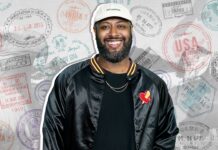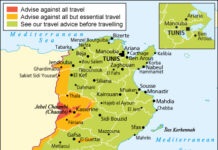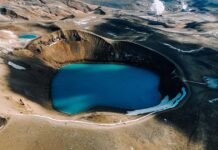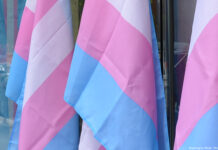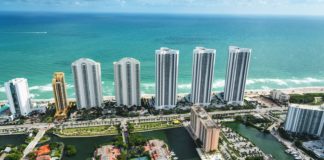Back in 2018, photographer Seth Caplan began to photograph friends and acquaintances who are queer nightlife creators. What emerged, in the end, was a celebration of New York’s queer nightlife in all of its messy glory. Over the next few months, we’ll be featuring each subject from this project in their own words, along with a portrait of them at home.
Who: Ms. Ter
What: Drag queen
Where: @mr.mster
November 2018
How did you start doing drag?
I’ve always been a creative person. I grew up in LA and always knew I wanted to do art as a kid. When I went into college, at UC Santa Cruz, I wanted to study art. We had to take a mixed-media class, and my teacher was a performance artist who I ended up working with. Performance allows me to do things that I couldn’t do in a two-dimensional space with painting and drawing. I was really inspired by Marina Abramovic, Chris Burden and Linda Montano. Linda did these pieces that were like life art. So you were a living sculpture, a living thing. And that’s what I got really into and did.
When I graduated, I moved back to LA, I was in a relationship, and I was like, I’m going to be a performance artist. And then I realized how hard it was. I would do these performance pieces at art galleries, and people would be like, “I don’t really understand performance art, but that was really good.” I hated that response because you don’t need a degree to understand performance art. It’s something that’s accessible too. I kind of fell into drag. I liked doing it a little bit in college but it always was for Halloween or Pride. I got more into the scene when I was in LA and realized that it was something that I wanted to pursue because it’s such an accessible form of performance art.
It’s really cool that you took the ideas you explored in school and are merging that with drag, a thing you did for fun as a queer person.
While I was getting more into drag, I was going to Dragula. It’s a television show now but it was hosted by the Boulet Brothers who are the horror queens of LA. It was a monthly drag horror night, essentially. It was where the weirdos would hang out and drink in a look. There was a competition at midnight for the best outfit. I would go to that every month, and that’s really where Ms. Ter formed. I wouldn’t perform, but it was the first time I’d go out in an intentional look and not just in a dress. I had a friend who introduced me to a drag queen who was performing in Laguna Beach who recommended me. I started performing there and was the only bearded queen. Through that, I started getting connections and working in Santa Ana and Orange County. At the time I decided that I was moving to New York though, I was getting booked a lot.
Having the ability to be who you want to be, but also be someone different through drag, is a fun fantasy.
What made you decide to come here?
I was bored with my life in LA. I moved there for a relationship after college, and we were no longer together and I felt aimless. I was working as a graphic designer, going out to drag bars, or going out doing this show once a month. My friend who I was living with at the time was moving to New York for grad school and I said, I’m just going to come with you. It seemed like a crazy decision at the time, but I didn’t realize how crazy. I dropped everything and moved to New York. Flash forward, she no longer lives here and now I’m still here. When I moved, I was not planning on definitely doing drag. I had to break into the scene again. I didn’t know what I wanted. I got a job, and then I started going out and meeting people and then started going out in drag again. I moved here during the summer of 2014 and by January it all happened again, I was doing shows.
I love asking people about their first experience going out to a queer nightlife space. Do you remember yours?
I can’t really remember what my first gay bar was, it must’ve been in LA when I was 18 or something. Probably Rage in WeHo because Rage had an 18-year-old night.
Was there something that stood out about the experience?
I think the first moment going to a gay bar was really scary. It was like, there are gonna be so many men there who are gay and it’s funny because now I literally only hang out with gay people. But I didn’t know any other queer people. I knew a few people in college, but there was also an intense sexual energy about gay bars. That’s what I perceived, a bunch of people who just want to have sex with me and I don’t want that energy, which I think says a lot about me. I’m more than that, it isn’t just who I am. But there was also potential.
In college, I was always the one who wanted to go to the bars. I wanted to dance and drink and hang out. It makes a lot of sense now that I liked the bars that I liked because at Rainbow Room in Santa Cruz, I would walk in and I knew everyone because I was friends with all the queer people. And that’s exactly how I operate now. I go to bars and I see everyone I know. I think I got more comfortable when I found bars that were mine. Once I started doing drag, it evolved and I was in control of the space, it was my space.
I love hearing you talk about your evolution of gay bars being an event and sort of scary, not being sure of how you relate to a new environment as a young gay person, and then being more comfortable with yourself, and more comfortable in those spaces. Now you have agency in those spaces as a performer. Can you talk about what you love about being a drag artist and what keeps you involved in queer nightlife?
Having the ability to be who you want to be, but also be someone different through drag, is a fun fantasy. You can get outside yourself. You can walk in a bar and be whoever you want. I introduce myself as Ms. Ter to people and they don’t question it. It’s this weird fucking thing where, my sister visited, I brought her out to Metropolitan, I was introducing her to people, and seeing it from her perspective, I thought, this is fucking insane. I was shouting to her, “this is Shiny Penny, this is Dream, this is like Gassy.” She asked me what their real names were and I was like, Laura, we don’t do that here. Whoever you introduce yourself as, that’s who you are. That fantasy is what keeps me coming back. It’s comfy, you go out and, I wouldn’t say it’s home necessarily, but I do feel at home in these spaces, in queer nightlife.
Why do you love performing as a drag queen?
I saw the people who I looked up to doing drag. In order to be a queen, I needed to participate in the way that queens participate. It wasn’t enough just to show up in a look, you need to perform. And I had a performance background. So I think that was where I first started. It was playing a part, and if I didn’t like it then I wouldn’t do it. But I saw I was good at it and I loved it.
I think the first moment going to a gay bar was really scary. It was like, there are gonna be so many men there who are gay and it’s funny because now I literally only hang out with gay people.
It’s fucking crazy when you get down to it. Drag is really fucking basic. It’s a person up on stage, lip-syncing to you. When you step back, you’re like, what are these fucking people doing? But I love it because you’re just living it. You’re living this fantasy and performing for people and getting them to join you. My favorite moment is when people are like, I haven’t heard this song in fucking forever, I’m so glad you’re performing this right now. I perform emo music from the early 2000’s. Like Hawthorne Heights, My Chemical Romance, Fall Out Boy. Mostly because it’s different, but also because it’s music that I really like. So when I perform it, I’m trying very hard, these are the emotions and the things that I feel while I’m performing. And I enjoy seeing people go, I know this song and I never would have expected a drag queen to perform it, and I haven’t heard it in years. That enjoyment is something that I really like getting out of people.

So who is Ms. Ter? And what is Ms. Ter about?
Ms. Ter started as an experiment of gender. Its base form is that I have a beard. What I love about it, and I think that’s partially why I perform male vocal songs, is to kind of draw this comparison and go, I can have a beard and still be gorgeous. People always say, “I don’t even see the beard on you anymore.” They didn’t notice the beard because everything else is just so much, and I perform hyperfemininity to such an extreme that they don’t see it. It’s a fun experiment of gender because I’m asking, can you be feminine and have a beard? So in the same way the music choices are part of that. Can I perform Fall Out Boy and still be femme? And the answer is yes. People call me the Chewbacca of Brooklyn drag. I’m huge, furry, and an imposing figure. One of my friends told me, because sometimes I work the door for parties even though I don’t love it but it’s a gig, she said, “you double as security and you don’t realize that, people aren’t gonna fuck with you because you’re six foot three.” I think Ms. Ter is also giving very bearded vampire.
That goes back to how people and spaces affect one another, which is why I love exploring how queer nightlife spaces give us permission to perform ourselves. As a drag performer, you get to have agency over that space, to be the things that you wanted to be but weren’t.
I give permission for people to be whoever they want, which is what I was always influenced by. I was influenced by the queens and the people that I sought out. They were always being whoever they wanted it to be and that gave me permission to do it. Now I try to give permission for people to do it. Even with my song choices, I’m not gonna perform Katy Perry for you. Whenever someone is living however they want to and are honest about it, that’s fucking commendable.
August, 2021
Hey Ms. Ter. It’s great to catch up with you. Let’s start by going back to the beginning of the pandemic. What was it like for you as lockdown started in NYC and did you connect with the digital transition of queer nightlife spaces and shows?
I think my last show was a few days before lockdown started. I woke up hungover, and then the next day there were no more shows. It was so abrupt. In the beginning, I was very optimistic about what the future was gonna look like. It was a hard moment where I had to delete my shows from my calendar.
I think Ms. Ter is also giving very bearded vampire.
I didn’t participate in a lot of digital shows. I did one benefit in April. It was fine. I realized very early on that digital drag was not something that I wanted to do. It was hard on varying levels. A lot of what I do in drag is for the performance of it. As much as I commend the people who were able to do it and make it work for themselves and people seem to really thrive in that space, for me, it felt lacking in what my whole purpose is.
It felt very hard for me to put on drag and do a five-minute performance and then take it off. Maybe if I had pursued it more I would have felt more of a desire, but I was busy working my day job. I was an essential worker at the store that I worked at. So I thought maybe this is time to break, time to take some me time. I flip-flopped a lot between buying things or working on looks, investing in my nightlife stuff, and then going through phases of thinking, what does it matter if I don’t know when I’m going to be able to wear it? It was a weird forced hiatus that wasn’t maybe as productive as it could have been.
I loved seeing that people were doing digital, it made me feel like people needed drag, and that some people were willing to provide it. I just wasn’t one of those people. It was also fabulous to see how traditional ways that we see drag can be completely changed. Being able to see shows in any city through digital was really cool.
Are there any ways you feel like your nightlife communities have intersected with coming together for social justice over the last year and a half?
The amazing thing about the digital world was how it connected to all these people and what they were feeling. It also made me feel like I was connected to all these beautiful people who were active in the protests and engagement in the conversation. It can be hard at drag shows and in nightlife to be very political.
I did my first show back in person for Wallbreaker at Metropolitan and it raised money for the Black Trans Travel Fund. There were a lot of people there. Junior Mintt, who is very involved with the Black Lives Matter protests and organizing, was there. It was nice to see how that conversation transitioned into the physical space of nightlife. I felt like political statements were this little part of nightlife before, and now it’s a much larger part of the conversations. I see people of color, trans people, marginalized people within the nightlife community taking control of the scene that they were so frequently left out of.
I loved seeing that people were doing digital drag, it made me feel like people needed drag, and that some people were willing to provide it.
What else were you up to this past fall and winter?
I was working and hibernating. I’m realizing I can live without things. I got okay with being by myself, which for a while I was struggling with. A lot of my self worth before the pandemic was fixated on how many funds I have, what shows I’m being booked for, what’s my Instagram following. I got to a point where my relationships with people that are genuinely important to me are what I need to focus on now. When I come back into nightlife, I’ll think about what my new outlook is. I am done doing drag for other people. It’s been over six years of doing drag. I always felt that I wasn’t doing it for anyone, but you can get stuck in this cycle being concerned about what the next show will be. Who was looking to get me as a guest queen on their show, when was my next recurring gig, etc. There were these markers that I felt were very important and I think I’m trying to unlearn that. How can I get back to the truest sense of why I’m doing what I’m doing?
What was returning to perform in person like for you?
My friend Anna-Lisa, who runs the show called Wallbreaker, which is a benefit show at Metropolitan, asked me to perform, which was my first in-person performance in June. It was fabulous. There was a big buildup because after not having done something for almost a year and a half and it’s like, can I still do this? I had to unbox all of my stuff because I had to move in March of this past year. I had a friend afterward who said it looked like it felt really, really good. And it did, it felt awesome to be back on stage. People were so happy to see drag again.
For Pride I did a last-minute gig. My friend, DJ Cameron Cole, needed someone to come in and perform for a show a few days before Pride Sunday. And that was nice and very fun. I was the only person, I did five numbers. The rest of the weekend, I hung out. I’m relearning how to be like a social person again.
Before, I was so up in needing to be out all the time because that’s how I got booked and how I met people. Now I’m more considered in fostering relationships with people who are already in my life, who come to my shows. Before the pandemic, I was breaking even with my gigs for the most part. I wasn’t making enough money for it to be super worth it financially. I hope that bars are aware that it’s not appropriate to just pay $50 for a show anymore. People come to see us do shows, so invest in your performers and make sure that they’re paid adequately because we are an essential part of this community. People are so hungry to go out right now, but that needs to be reflected in payment, too.
What are your hopes and goals for yourself and nightlife now?
I’m excited to see things coming back. I hope that more spaces either open back up or expand. Some of the bars that I frequently worked at before the pandemic closed permanently, which was a bummer. You’re losing homes, where people feel safe, or where they build community when that happens. I’m hopeful that people will take initiative invest in queer spaces and create new ones.
I want to invest in my abilities, the little things that make a drag queen, like making hair, making outfits, investing in pieces and jewelry. Whenever I have time to sit back and reflect on what I put out there. How can I make it better? Now, I have time and money to do it. And I think if the pandemic really taught us anything, it’s that shit can go down at any time.♦
Text and Photography by Seth Caplan. Read his statement here.


